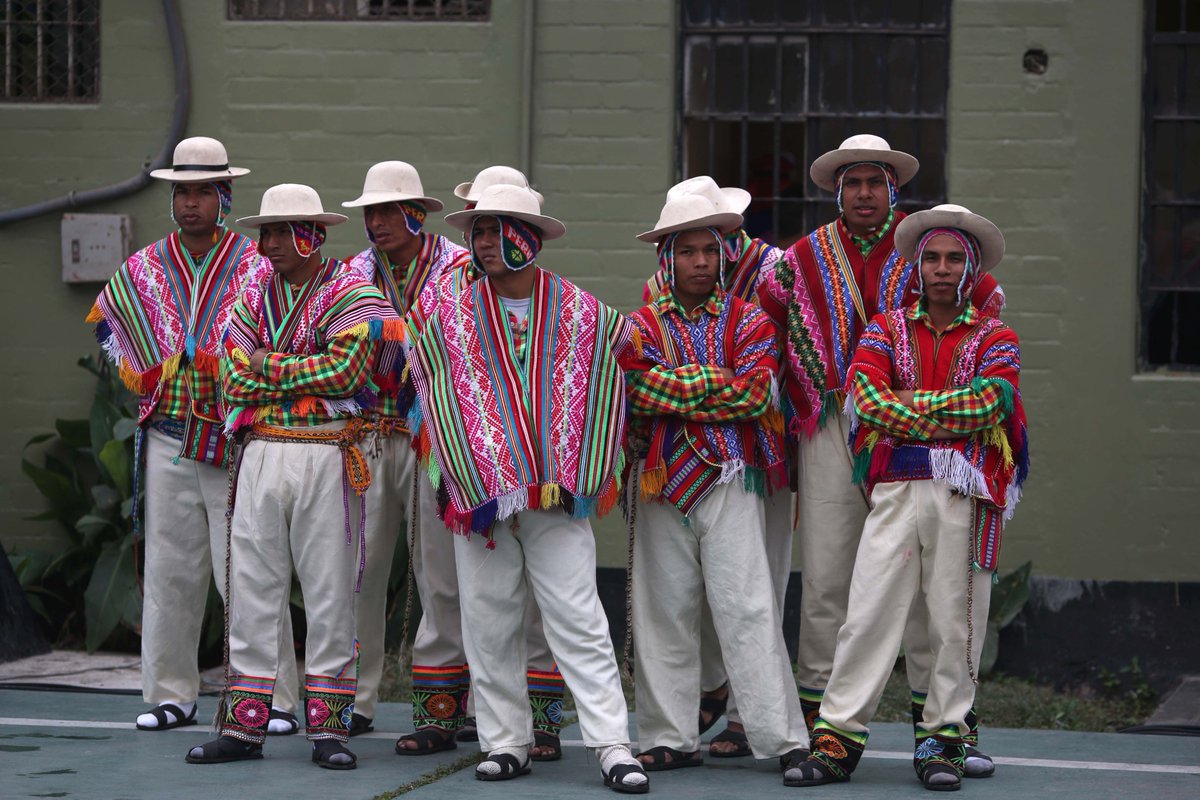Name for Traditional Dress of Native Women Peru

Even in the 21st century, people in the Peruvian Andes still wear the clothes worn by the dolls in my collection. The majority of the Andean Amerindians in Peru belong to Quechua–speaking ethnic groups, though there are other ethnic groups living there, too. In fact, the Quechua and Aymara of the Andes mountains are the largest group of Indians still existent in the New World. The names given to the clothes described below are in Quechua or Spanish.
The basic material for the production of the wool clothing comes from the camelids of the Andean region: alpaca, guanaco, and llama.
Women's clothing
The standard clothes for an Andean Peruvian peasant woman consist of a lliclla, a jobona, a k'eperina, many polleras and a montera. The lliclla is a small rectangular handwoven shawl fastened at the front using a decorated pin (tupu) or a large safety pin. It can also be tied in a knot. The jobona or woollen jacket is worn under the lliclla. This type of jacket is decorated in colourful patterns of buttons. Andean women also wear a second larger shawl-like cloth over their backs and knotted in front. This is called a k'eperin and is used for carrying both children and goods. Another method of transporting goods used by women is with a small rectangular cloth (unkuña), which is used for carrying snacks such as corn or coca. Coca is important in this region as it is used as a stimulant to overcome fatigue, hunger, and thirst. It is also effective against altitude sickness (useful as the Andes have an average height of 4,000 m).
Peruvian women also wear colourful skirts (polleras) made from a handwoven woollen cloth called bayeta. They may wear three or four in a graduated layer effect. On special occasions, such as festivals, women may wear up to 15 polleras tied around the waist. Often the trim of each skirt is lined with a colourful puyto which is usually handmade. These puyto can vary from a narrow band with one or two colours, to a wide, multi-coloured band that covers most of the skirt. The style of the polleras is often an indicator of where a woman is from.

In addition, Peruvian women wear hats (monteras), the form of which can vary greatly throughout the Andean communities. As with the polleras, it is often possible to identify the village from which a woman comes from just by the type of hat she wears. The hats are secured with delicately woven sanq'apa straps adorned with white beads.

Men's clothing
Peruvian men wear dark wool knee-length handwoven bayeta pants. A woven belt called a chumpi is also worn which provides protection to the lower back when working in the fields. The most distinctive part of Peruvian men's clothing is the handwoven poncho. Nearly every Quechua man and boy has a poncho, generally red in colour. They are decorated with intricate designs with each district having a distinctive pattern. Ponchos are worn as daily attire in some communities (such as Huilloc, Patacancha, and many villages in the Lares Valley); however, most men use their ponchos only on special occasions (e.g. festivals, village meetings, weddings, etc.). The men's fine dress includes a woollen waistcoat (chaleco), which is similar to the sleeveless juyuna worn by the women. The chalecos can be richly decorated.
Chullos are frequently worn by Peruvian men. These are knitted hats with earflaps and are often sold in third world shops in Europe. The first chullo that a child receives is traditionally knitted by his father. In the Ausangate region, chullos are often ornately adorned with white beads and large tassels called t'ikas. Men sometimes wear a felt hat called a sombrero over the top of the chullo that is decorated with finely decorated hatbands or centillo.
Since ancient times, men have worn small woven pouches called chuspas (equivalent to the women's unkuña). These are used to carry their coca leaves with a small separate pouch used for llipta, the lime ash catalyst that activates the alkaloids in coca. The chuspa even pre-dates Inca times.
Nowadays, both men and women wear ajotas on their feet: the cheap and durable sandals made from recycled tyres.
Source(s) of information
http://en.wikipedia.org/wiki/Indigenous_peoples_in_Peru
http://en.wikipedia.org/wiki/Quena
http://www.myperu.org/traditional_clothing_peru.html,
http://www.threadsofperu.com/weaving-culture/traditional-dress/
https://www.encyclopedia.com/environment/encyclopedias-almanacs-transcripts-and-maps/south-american-indians-indians-modern-andes#:~:text=The%20Quechua%20and%20Aymara%20Indians,and%20in%20the%20Andean%20highlands.
Picture sources
1) Andean women with various styles of clothing and hats (and llamas) – https://pixabay.com/de/peru-peruanische-kost%C3%BCm-2422775/
2) Mother and child – http://www.inside-peru.com/traditional-peruvian-clothing.html
3) Peruvian men – https://www.scoopnest.com/user/ajplus/767861092735262720
Map – https://commons.wikimedia.org/wiki/File:Andes.png
(6.5.0)
Source: https://babogenglish.wordpress.com/2012/09/04/andes-region-peru/
0 Response to "Name for Traditional Dress of Native Women Peru"
Postar um comentário